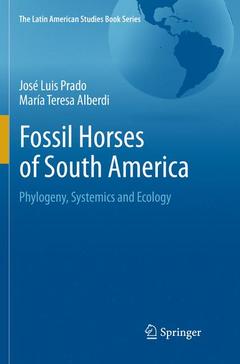Fossil Horses of South America, Softcover reprint of the original 1st ed. 2017 Phylogeny, Systemics and Ecology The Latin American Studies Book Series
Auteurs : Prado José Luis, Alberdi María Teresa

Professor Prado is internationally known for his contributions to the study of fossil horses and paleobiology in South America. He has published over 140 articles in leading international journals, including Nature, Science, PNAS, BMC ecology and Evolutionary Ecology. Prof. Prado. He has also extensive experience managing large research grants. He is frequently invited to present his research at international conferences. His research has made substantial contributions to our understanding of horse evolution, particularly in relation to diversification and extinction processes.
Dr. Alberdi is an internationally respected paleontologist who has extensive experience in South America. She currently works at the National Museum of Natural Sciences (CSIC) in Spain, where she was a Vice-Director and also head of the Paleontology department. She is active at the Natural Resources Scientific Committee and is a reviewer for a number of leading paleontology and vertebrates journals.Is a fascinating book about the development and extinction of horses in America
Written by two very prestigious mammal paleontologists
Researches the origins of horses in America and their extinction in Late Glacial times
Includes supplementary material: sn.pub/extras
Date de parution : 07-2018
Ouvrage de 150 p.
15.5x23.5 cm
Disponible chez l'éditeur (délai d'approvisionnement : 15 jours).
Prix indicatif 52,74 €
Ajouter au panierDate de parution : 05-2017
Ouvrage de 150 p.
15.5x23.5 cm
Disponible chez l'éditeur (délai d'approvisionnement : 15 jours).
Prix indicatif 52,74 €
Ajouter au panier


